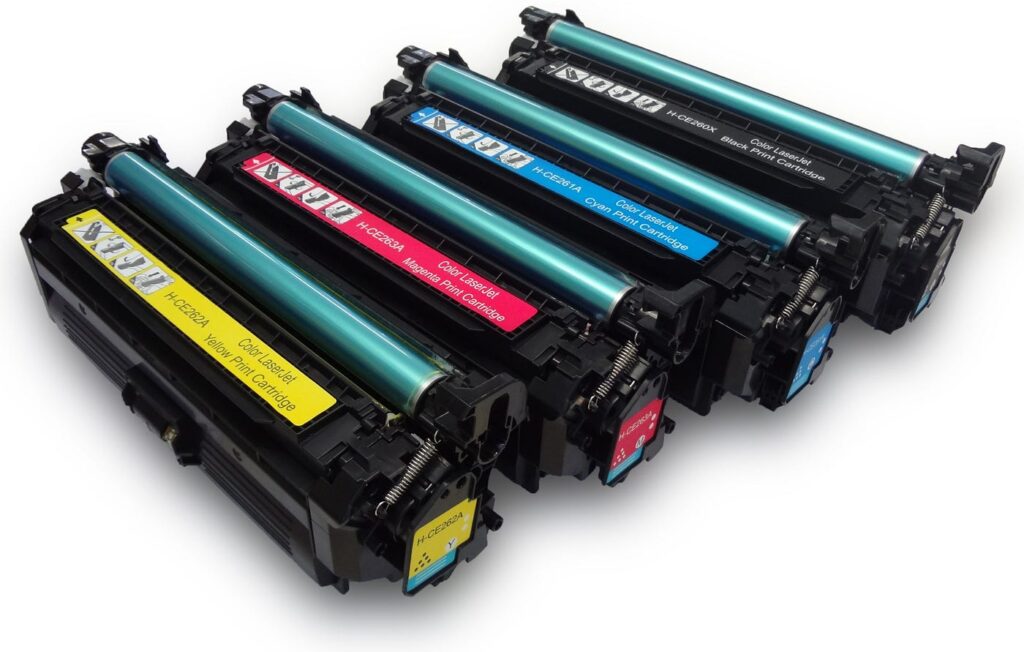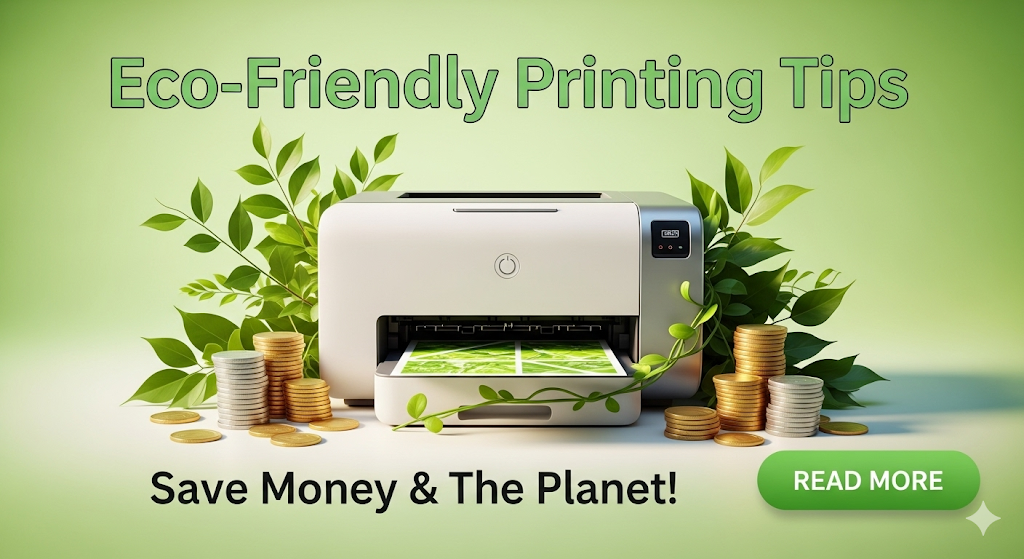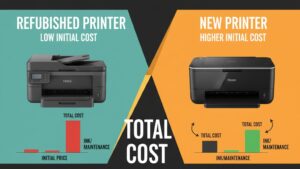Introduction
Eco-friendly printing tips are transforming how businesses and individuals approach document production while protecting our planet. With rising environmental concerns and increasing operational costs, sustainable printing practices have become essential for conscious consumers and organizations.
Traditional printing methods consume massive amounts of paper, ink, and energy. This creates significant environmental impact through deforestation, chemical waste, and carbon emissions. However, implementing smart eco-friendly printing tips can reduce your carbon footprint by up to 30% while cutting printing costs dramatically.
Modern sustainable printing solutions offer practical ways to maintain productivity without compromising environmental responsibility. From choosing recycled materials to optimizing print settings, these strategies deliver immediate benefits for your wallet and the planet.
What Are Eco-Friendly Printing Tips?
Eco-friendly printing tips encompass strategies and practices designed to minimize environmental impact while maintaining document quality and reducing costs. These approaches focus on sustainable resource usage, waste reduction, and energy efficiency throughout the printing process.
The concept involves three core principles: reducing paper consumption, using environmentally responsible materials, and optimizing printer performance. This includes selecting recycled paper, vegetable-based inks, energy-efficient printers, and implementing smart printing policies.
Sustainable printing practices extend beyond material choices. They include digital-first workflows, duplex printing, draft mode usage, and proper printer maintenance. These methods significantly reduce resource consumption while maintaining professional document standards.
Environmental benefits include decreased deforestation, reduced chemical runoff, lower energy consumption, and minimized landfill waste. Financial advantages encompass reduced supply costs, lower energy bills, extended equipment lifespan, and improved operational efficiency.
Modern eco-friendly printing tips leverage technology to automate sustainable choices. Print management software, cloud-based solutions, and smart printer settings make environmentally conscious printing effortless and cost-effective for users of all technical levels.
8 Powerful Eco-Friendly Printing Tips to Transform Your Habits

Tip 1: Master Double-Sided Printing
Enable duplex printing as your default setting to instantly cut paper usage by 50%. Most modern printers support automatic double-sided printing, eliminating manual intervention while maximizing paper efficiency.
Configure your printer settings to prioritize duplex mode for all document types. This simple change reduces paper costs, storage space requirements, and environmental impact without affecting document quality or readability.
Tip 2: Optimize Print Quality Settings
Use draft or eco-mode for internal documents, emails, and rough drafts. These settings consume up to 50% less ink while maintaining acceptable readability for everyday business communications.
Reserve high-quality settings for client presentations, final reports, and external communications. This strategic approach balances professional appearance with resource conservation and cost savings.
Tip 3: Choose Recycled and Sustainable Papers
Select paper made from 100% post-consumer recycled content or sustainably managed forests certified by FSC (Forest Stewardship Council). These options reduce deforestation impact while supporting responsible forestry practices.
Consider alternative paper materials like bamboo, hemp, or wheat straw. These rapidly renewable resources offer comparable quality to traditional wood-based papers with significantly lower environmental impact.
Tip 4: Implement Smart Font and Formatting Choices
Use eco-friendly fonts like Century Gothic, Calibri, or Times New Roman that require less ink coverage. Avoid bold formatting unless necessary, and reduce font sizes when appropriate without compromising readability.
Adjust margins, line spacing, and page layouts to maximize content per page. Strategic formatting reduces page count while maintaining professional document appearance and improving information density.
Tip 5: Embrace Digital-First Workflows
Prioritize digital document sharing, electronic signatures, and cloud-based collaboration tools. This approach eliminates unnecessary printing while improving document accessibility, version control, and collaborative efficiency.
Print only final versions or documents requiring physical signatures. Implement review processes using digital annotation tools to minimize draft printing and paper waste.

Tip 6: Maintain Your Printer Properly
Perform regular printer cleaning cycles, replace cartridges promptly, and keep printheads clean. Proper maintenance ensures optimal ink usage, prevents waste from poor print quality, and extends equipment lifespan.
Schedule professional servicing annually to maintain peak efficiency. Well-maintained printers consume less energy, produce better results, and require fewer reprints due to quality issues.
Tip 7: Choose Refillable or Compatible Cartridges
Use refillable ink cartridges or high-quality compatible alternatives to reduce plastic waste and manufacturing impact. These options typically cost 60-80% less than original cartridges while delivering comparable print quality.
Participate in cartridge recycling programs offered by manufacturers or local electronics retailers. Proper disposal prevents toxic chemicals from entering landfills and supports circular economy principles.
Tip 8: Monitor and Analyze Printing Habits
Install print management software to track usage patterns, identify waste sources, and implement targeted improvements. These tools provide detailed analytics on paper consumption, ink usage, and cost allocation.
Set monthly printing quotas and encourage conscious printing decisions. Regular monitoring creates awareness and motivates sustainable behavior changes among team members and family members.

Advanced Tools and Insights for Sustainable Printing
Print management solutions like PaperCut, PrinterLogic, and EveryonePrint offer comprehensive sustainability tracking and automated eco-friendly settings. These platforms integrate with existing infrastructure to optimize resource usage without disrupting workflows.
Cloud-based printing services reduce energy consumption by centralizing print processing and enabling smart routing to the most efficient available printer. Services like Google Cloud Print alternatives and manufacturer-specific solutions streamline operations while reducing environmental impact.
Mobile printing apps often include eco-friendly features like automatic duplex selection, draft mode defaults, and page range optimization. These tools make sustainable choices effortless for smartphone and tablet users.
Consider investing in ENERGY STAR certified printers that consume up to 40% less energy than conventional models. These devices automatically enter sleep mode, optimize power usage, and reduce operational costs significantly.
Common Mistakes and Troubleshooting Eco-Friendly Printing
Ignoring Default Settings Configuration
Many users fail to configure eco-friendly defaults, leading to wasteful printing habits. Access your printer’s control panel or software settings to enable duplex printing, draft mode, and energy-saving features permanently.
Update driver settings on all computers accessing shared printers. Inconsistent configurations across devices can undermine sustainability efforts and create confusion among users.
Choosing Cheap Over Sustainable Options
Low-quality recycled paper or compatible cartridges can cause jams, poor print quality, and equipment damage. Invest in certified sustainable products from reputable manufacturers to ensure reliability and performance.
Research supplier certifications and environmental credentials before making purchasing decisions. Genuine eco-friendly products deliver better long-term value despite potentially higher upfront costs.
Overlooking Printer Placement and Environment
Poor printer placement in direct sunlight, humid areas, or dusty environments accelerates wear and reduces efficiency. Position printers in climate-controlled areas with adequate ventilation and protection from environmental factors.
Ensure proper clearance around printers for heat dissipation and easy maintenance access. Cramped spaces increase energy consumption and complicate routine cleaning procedures.
Neglecting Regular Maintenance Schedules
Inconsistent maintenance leads to increased ink consumption, poor print quality, and premature equipment failure. Establish monthly cleaning routines and annual professional servicing schedules to maintain optimal performance.
Monitor ink levels proactively and replace cartridges before complete depletion. Running printers with empty cartridges can damage printheads and require costly repairs.
Frequently Asked Questions
Q: How much money can eco-friendly printing tips actually save? A: Implementing comprehensive eco-friendly printing tips typically reduces printing costs by 20-40%. Double-sided printing alone cuts paper expenses in half, while draft mode settings reduce ink consumption by up to 50%.
Q: Do recycled papers work in all printer types? A: High-quality recycled papers work excellently in most modern printers. Choose papers specifically designed for your printer type (inkjet or laser) and avoid extremely cheap options that might cause feeding problems.
Q: Are compatible ink cartridges really as good as originals? A: Premium compatible cartridges often match original quality while costing 60-80% less. Research reputable suppliers and read reviews to identify reliable compatible options for your specific printer model.
Q: How do I convince my office to adopt sustainable printing practices? A: Present cost savings data, environmental impact metrics, and implementation ease. Start with simple changes like default duplex settings and gradually introduce more comprehensive eco-friendly printing tips as acceptance grows.
Conclusion
Eco-friendly printing tips offer powerful solutions for reducing environmental impact while achieving significant cost savings. By implementing these eight transformative strategies, you can cut printing expenses by up to 40% while protecting our planet’s precious resources.
The key to success lies in making sustainable choices automatic through proper configuration, quality material selection, and regular maintenance routines. These practices require minimal effort but deliver maximum impact for both your budget and the environment.
Start your sustainable printing journey today by enabling duplex printing, choosing recycled materials, and monitoring your usage patterns. Small changes create substantial cumulative benefits that protect the planet while keeping more money in your pocket.
Remember that eco-friendly printing tips work best when applied consistently across all your printing activities. Transform your habits gradually, and you’ll soon discover that sustainable printing is both economically smart and environmentally responsible.
Wireless Printing from Phone: Ultimate Guide to Print Effortlessly Read More.




